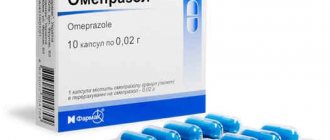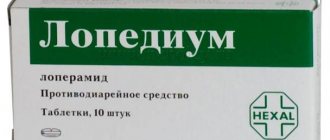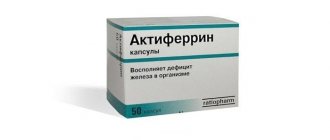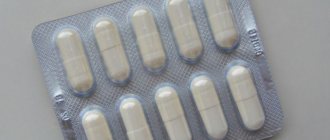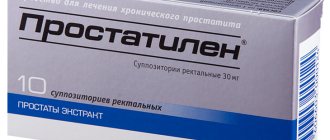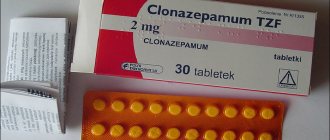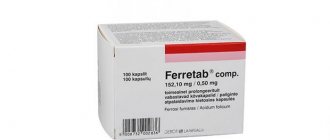Emanera is an effective antiulcer drug, characterized by a specific, targeted mechanism of action - suppression of the secretion of gastric hydrochloric acid. In the acidic environment of the secretory tubules of the parietal cells lining the gastric mucosa, it becomes active and reduces the basal and stimulated secretion of hydrochloric acid.
Emanera tablets (although this is a common name, the drug is available in capsules) are included in the treatment regimen for Helicobacter pylori, demonstrate high effectiveness in the complex treatment of infection and help prevent relapses.
Pharmacological group: A drug that reduces the secretion of gastric glands.
Composition, physical and chemical properties, price
The drug is available in the form of capsules of 20 and 40 mg with enteric body and cap.
| Main substance (pellet core) | 20.645 or 41.29 mg esomeprazole magnesium |
| Auxiliary components (pellet core) | Granulated sugar, povidone, sodium lauryl sulfate |
| Pellet shell | Opadry II white, magnesium hydroxycarbonate, methacrylic acid and ethyl acrylate copolymer (1:1); 30% dispersion, talc, macrogol 6000, titanium dioxide, polysorbate 80 |
| Gelatin capsules | Red iron oxide dye, titanium dioxide, gelatin |
| Physicochemical characteristics | Light pink capsules with white (or almost white) pellets inside |
| Package | 7, 14, 28 capsules in a blister, in cardboard packs |
| Price | 20 mg No. 14: 170-300 rub., 40 mg No. 14: 270-600 rub. |
pharmachologic effect
The active ingredient Emanera (esomeprazole) is an inhibitor of proton transport of parietal cells of the gastrointestinal tract. Omeprazole has two isomers: esomeprazole (S-isomer) and R-isomer. The pharmacodynamics of both isomers are approximately the same, but the first is usually used to treat gastric ulcers.
The active substance of the drug is a weak base: in an acidic environment, the concentration of the base increases, it turns into an active form that inhibits the enzyme H+K+-ATPase - the acid pump. This causes suppression of basal and stimulated acid secretion.
Already 1 hour after administration, the production of acids in the gastrointestinal tract is suppressed. The effectiveness of the drug depends on its plasma concentration.
- Taking 20 mg of the drug once a day for 5 days in a row leads to a significant decrease in the concentration of hydrochloric acid (by about 91%).
- Treatment with a dose of 40 mg for 1 month in patients with reflux esophagitis leads to cure in 78% of cases. With a two-month course, the probability of recovery is 93%.
- Taking esomeprazole at a dose of 40 mg daily in combination with antibiotics for 1 week leads to recovery in 90% of patients with gastric ulcers associated with Helicobacter pylori.
- The drug is more effective in treating patients with gastric ulcers who have used nonsteroidal anti-inflammatory drugs compared to ranitidine, and is therefore the preferred drug of choice.
Emanera is prescribed for the healing of ulcers that developed while taking non-steroidal anti-inflammatory drugs, selective COX-2 inhibitors. It is also often prescribed in complex therapy to prevent stomach ulcers when treated with specific medications that can destroy the gastrointestinal mucosa.
Recommendations for administration through a tube
The administration of Emanera through a tube requires compliance with several rules:
- Carefully open the capsule and pour the contents into the syringe. Add 30 ml of water (up to 50 ml) and 5 g of air.
- Shake the mixture until a homogeneous mass is obtained.
- The tip is inserted vertically.
- The spitz is shaken off, turned over with the tip down, and 5-10 ml of solution is slowly introduced.
- After insertion, the syringe is turned upward and held in this way to avoid clogging.
- The spitz is lowered and shaken again, after which another 10-15 ml should be injected.
- The procedure is repeated until completely empty.
- If there is any sediment left on the walls of the syringe, add more water and air and repeat the procedure.
Interesting! Sphincters of the digestive system: treatment of pathologies
Important! Emaner capsules and instructions for their use are provided for informational purposes only. You should consult your doctor before use.
Pharmacokinetics and pharmacodynamics
Esomeprazole is destroyed in an aggressive acidic environment, so the active substance is placed in an enteric capsule, inside of which there are drug pellets - the pellet shell is also resistant to gastric juice. A small proportion of the substance is transformed into the R-isomer in vivo. During food intake, the absorption of esomeprazole is slightly reduced, but not significantly.
The drug is well absorbed from the gastrointestinal tract, the maximum in the blood plasma is determined within 1-2 hours. Bioavailability is 64%, and with long-term use reaches 89%. The absorption efficiency is to some extent influenced by the food eaten in parallel with the drug. 97% bound to plasma proteins.
Esomeprazole is metabolized in the liver under the influence of cytochrome P450, as well as with the participation of isoenzymes CYP3A4 and CYP2C19. Plasma clearance after a single dose is 17 liters per hour, with prolonged use - 9 liters per hour. In patients with reduced CYP2C19 activity, esomeprazole is metabolized by CYP3A4, with increased concentrations. In patients with kidney and liver pathologies, the metabolism of the active substance may be disrupted. Pharmacokinetics in patients over 12 years of age are practically no different from those in adults.
Does not accumulate or accumulate in tissues. The half-life is about 1.5 hours; with long-term treatment, this period lengthens. If the drug is taken once, it is eliminated from the body very quickly. Metabolites are excreted by the kidneys or intestines; about 1% of the substance is present in the urine unchanged.
Pregnancy and breastfeeding
The use of the drug Emanera during pregnancy is allowed if the specialist evaluates the benefit for the pregnant woman as higher than the possible consequences for the intrauterine development of the fetus, since there is no information about the use of the pharmacological drug during pregnancy.
According to animal studies, scientists do not note a negative effect on the intrauterine development of the child or on the course of pregnancy.
There is no data on whether the active substance is excreted in mother's milk. Therefore, you will have to stop taking this medicine while you are breastfeeding.
Pharmacokinetics in certain patient groups
- About 3% of people have reduced activity of the CYP2C19 isoenzyme, so the drug is metabolized with the participation of CYP3A4. The average plasma concentration of the drug in such patients is 60% higher.
- In elderly people (over 71 years of age), there were no significant changes in the metabolism of the drug.
- In women, there is an increase in mean AUC of approximately 30% after a single dose. Subsequently, no sex differences in pharmacokinetics are observed.
- In severe liver dysfunction, the metabolic rate is reduced, so the maximum dose for such patients is 20 mg per day.
Indications for use
The use of Emanera is indicated in the following cases:
- GERD;
- stomach and duodenal ulcers, including those caused by Helicobacter pylori;
- prevention of gastrointestinal tract diseases that can develop while taking NSAIDs;
- erosive reflux esophagitis;
- maintenance therapy after cured erosive reflux esophagitis and peptic ulcers (prevention of relapse);
- diseases caused by Helicobacter pylori;
- prevention of re-development of peptic ulcers and repeated bleeding of them during treatment with NSAIDs and after intramuscular administration of drugs that can reduce the secretion of hydrochloric acid;
- conditions associated with increased gastric secretion (idiopathic hypersecretion inclusive);
- Zollinger-Ellison syndrome.
Contraindications
Instructions for use for Emanera tablets prohibit taking:
- lactation period;
- hypersensitivity to the components of the drug;
- hypersensitivity to substituted benzimidazoles;
- children under 12 years of age (no data on effectiveness and safety);
- simultaneous use with atazanavir and nelfinavir;
- children over 12 years of age for indications other than GERD;
- hereditary fructose intolerance, glucose-galactose malabsorption syndrome or sucrase-isomaltase deficiency.
special instructions
The instructions for use of Emanera indicate that in case of liver dysfunction, the dose does not need to be adjusted. But if there are serious disorders in the liver, then the maximum daily dose is only 20 mg.
If symptoms of oncological pathology develop during treatment (vomiting with blood, severe weight loss, loss of appetite), it is important to exclude the possibility of cancer, perform additional studies and postpone treatment until the presumptive diagnosis is refuted.
Long-term treatment requires medical supervision. In addition, such patients should immediately consult a doctor if any change in symptoms is observed.
The drug contains sucrose.
Concentration and reaction speed are not affected.
Prescription during pregnancy is justified only if the expected positive effect for the mother exceeds the likely risks for the fetus. Epidemiological studies and experiments on animals did not reveal fetotoxic effects or pathologies of fetal development during treatment with Emanera, but this is not a basis for the free use of Emanera in pregnant women.
When using Emanera for the treatment of Helicobacter pylori, it is important to consider the interaction of drugs included in triple therapy. Thus, clarithromycin, which is included in the regimen, is a strong inhibitor of CYP3A4 - it is important to consider contraindications and antibiotic interactions for patients concomitantly taking medications metabolized by CYP3A4.
Overdose
According to Emaner's instructions, overdose occurs very rarely. When taking a dose of 280 mg, gastrointestinal upset and weakness begin. A single dose of 80 mg does not cause disorders. There is no specific antidote for treating an overdose of Emanera, because esomeprazole binds to plasma and blood proteins and is poorly excreted by hemodialysis. In case of overdose, symptomatic treatment should be carried out and measures should be taken to maintain body functions in accordance with medical instructions.
Side effects
During the course of treatment, the level of hydrochloric acid in the stomach decreases significantly. This leads to an increase in serum gastrin levels, as well as the growth of enterochromaffin-like cells.
Treatment increases the risk of formation of glandular cysts in the stomach, which are benign, do not require surgical intervention and are reversible.
Also, treatment to some extent increases the risk of infectious diseases (salmonellosis, and others). This is due to the fact that a decrease in the acidity of the stomach contents leads to an increase in the amount of microbial flora that is normally there.
During treatment, the following effects may occur:
- CNS: headache, insomnia, drowsiness, dizziness, depression, overexcitation of the central nervous system, hallucinations, aggression, sweating, weakness;
- Gastrointestinal tract: changes in the perception of taste, constipation or diarrhea, vomiting, flatulence, dry mouth, abdominal pain, hepatitis, candidiasis, exacerbation or development of liver diseases;
- Urinary system: nephritis, edema;
- Respiratory system: bronchospasm;
- Reproductive system: gynecomastia;
- Musculoskeletal system: myalgia, muscle weakness, arthralgia;
- Visual organs: temporary decrease in vision;
- Hypersensitivity reactions: urticaria, angioedema, skin rashes, dermatitis, alopecia, anaphylactic shock, sensitivity to light, Steven-Johnson syndrome;
- Blood disorders: agranulocytosis, thrombocytopenia, leukopenia, pancytopenia, hyponatremia, hypomagnesemia, hypocalcemia, hypokalemia.
Dosage
Take orally, without crushing or chewing, and wash down with plenty of water. If the patient cannot swallow the drug for health reasons, the contents of the capsules can be dissolved in clean water (half a glass), stirred and the resulting solution taken 30 minutes after mixing. After this, add more water to the same glass, rinse the walls of the glass with it and drink. Liquids other than water are not allowed - the protective shell of the pellets may dissolve. Also, do not crush or chew the pellets.
Administration through a nasogastric tube is possible as follows: pour the contents of the capsule into a special syringe, add 25-50 ml of water and leave 5-10 ml of air, shake well until a suspension is formed. The tip of the syringe is checked for patency and connected to the probe (holding the tip up), then the syringe is quickly shaken and turned over, part of the suspension (5-10 ml) is immediately injected into the probe. Turn the syringe over again with the tip up, shake, tilt and again inject part of the suspension. The cycle is repeated until all the drug has been administered. If part of the drug remains as a sediment in the syringe or on its walls: fill the syringe with 25 ml of water and leave 5 ml of air and repeat the cycle described above.
The duration of treatment and dosage are always selected by the attending physician, taking into account the following recommendations:
- Symptomatic treatment of GERD: 20 mg 1 time per day for 4 weeks (the course can be extended further, but only after examination, if there is no improvement after 4 weeks of treatment);
- treatment of erosive reflux esophagitis: 40 mg 1 time per day for 30 days (the course can be extended for another month, but after a break);
- prevention of GERD and support to prevent relapse: 20 mg 1 time per day;
- stomach and duodenal ulcers (including those caused by Helicobacter pylori): in complex therapy, 20 mg of the drug 2 times a day for 1-2 weeks;
- treatment of stomach ulcers during NSAID therapy: 20-40 mg once a day, 1-2 months;
- prevention of stomach ulcers: 20-40 mg 1 time per day;
- prevention of bleeding from peptic ulcers after intravenous administration of drugs that reduce hydrochloric acid levels: 40 mg once a day for 1 month;
- idiopathic hypersecretion, Zollinger-Ellison syndrome and other conditions characterized by hyperactive gastric secretion: 40 mg 2 times a day. The dose and duration of treatment are selected individually, but most often a dose of 80-160 mg/day is sufficient.
Emanera
Emanera ®
(lat.
Emanera
®) - antiulcer drug, proton pump inhibitor (PPI).
Composition of Emanera
Emanera is available in the form of enteric-coated capsules, 20 mg and 40 mg. The active substance of Emanera is esomeprazole. One capsule of Emanera contains:
- active substance: 20.645 mg or 41.29 mg esomeprazole magnesium, corresponding to 20 mg and 40 mg esomeprazole
- excipients (including pellet shell and capsule substance): granulated sugar (contains sucrose and starch molasses), povidone K30, sodium lauryl sulfate, Opadry II white 85F28751 (polyvinyl alcohol, titanium dioxide (E171), macrogol 3000, talc), heavy magnesium carbonate , methacrylic acid and ethyl acrylate copolymer (1:1), dispersion 30% Eudragit L30D, talc, macrogol 6000, red iron oxide dye (E172), gelatin.
Indications for use of Emanera
Gastroesophageal reflux disease (GERD):
- treatment of erosive reflux esophagitis
- long-term maintenance treatment after healing of erosive reflux esophagitis to prevent relapse
- symptomatic treatment of GERD
Peptic ulcer of the stomach and duodenum: As part of combination therapy (monotherapy with Emanera is not used for HP eradication):
- treatment of gastric and duodenal ulcers associated with Helicobacter pylori
(Hp) - prevention of relapses of peptic ulcer disease associated with Hp
With long-term use of non-steroidal anti-inflammatory drugs (NSAIDs):
- healing of stomach ulcers associated with taking NSAIDs
- prevention of gastric and duodenal ulcers associated with taking NSAIDs in patients at risk
Zollinger-Ellison syndrome
or other conditions characterized by pathological hypersecretion, including idiopathic hypersecretion.
Method of administration of Emanera and dose
The Emanera capsule is swallowed whole with liquid.
The capsules are not chewed or crushed. If you have problems swallowing, the capsule is dissolved until it disintegrates into microgranules in 100 ml of still water, after which all microgranules are drunk immediately or within half an hour, then another 100 ml of still water is added, the remainder is stirred and drunk. GERD
- one or two courses (the second - if the first is not enough to heal or get rid of the symptoms of esophagitis), each for 40 days, 40 mg of Emanera once a day
- maintenance therapy after healing of esophagitis - 20 mg Emanera once a day for a long period
- symptomatic treatment of GERD without esophagitis - 20 mg Emanera once a day; symptoms should disappear within 4 weeks
Stomach and duodenal ulcers (adults only)
- treatment of duodenal ulcers or prevention of peptic ulcers associated with Helicobacter pylori
- twice a day: Emanera 20 mg, amoxicillin 1 g and clarithromycin 500 mg for a week;
it is possible to use Emanera as part of other eradication regimens ( see “Standards for diagnosis and treatment of acid-dependent and Helicobacter pylori-associated diseases (4th Moscow agreement)”
). - Treatment of stomach ulcers associated with NSAIDs: Emanera 20 mg or 40 mg once daily for 4-8 weeks
- prevention of gastric and duodenal ulcers associated with NSAIDs: Emanera 20 mg or 40 mg once a day
Conditions associated with pathological hypersecretion (adults only)
, including Zollinger-Ellison syndrome and idiopathic hypersecretion. The starting dose is 40 mg Emanera twice a day. Next, the dose is selected individually, the duration of treatment depends on the development of the disease.
Pharmacological properties of Emanera
The pharmacokinetics and pharmacodynamics of Emanera are determined by the active substance and are described in the article esomeprazole in the sections pharmacokinetics of esomeprazole
and
pharmacodynamics of esomeprazole
.
Contraindications to Emanera therapy
- hypersensitivity to esomeprazole, substituted benzimidazoles or other ingredients included in the drug
- hereditary fructose intolerance, glucose-galactose malabsorption or sucrase-isomaltase deficiency
- Emanera should not be taken with atazanavir
- with caution in severe renal failure
Use of Emanera during pregnancy and breastfeeding
During pregnancy, Emanera therapy is possible only for health reasons.
When taking Emanera, you must stop breastfeeding. The FDA category of risk for the fetus when using Emanera in a pregnant woman is B (animal studies have not revealed the risk of negative effects on the fetus; there have been no adequate studies in pregnant women).
Side effects of Emanera
Headache, abdominal pain, diarrhea, flatulence, nausea, vomiting, constipation, dermatitis, itching, urticaria, rash, dizziness, dry mouth, insomnia, paresthesia, drowsiness, increased activity of liver enzymes, peripheral edema.
Long-term or high-dose use of Emanera increases the risk of hip, wrist, and spine fractures (“FDA Warns”).
Overdose of Emanera
Taking Emanera at a dose of 280 mg is accompanied by general weakness and symptoms from the gastrointestinal tract. A single dose of 80 mg of Emanera does not cause any negative effects. Specific antidotes are unknown. Esomeprazole binds to plasma proteins, making dialysis ineffective. In case of overdose, symptomatic and general supportive treatment is provided.
Special instructions for Emanera therapy
If any alarming symptoms are present (for example, significant spontaneous weight loss, repeated vomiting, dysphagia, hematemesis, or melena), or if a gastric ulcer is present or suspected, the presence of a malignant neoplasm should be excluded, since treatment with Emanera may lead to flattening symptoms and delay diagnosis.
Those taking Emanera for a long period (especially more than a year) should be under regular medical supervision. Those taking Emanera "as needed" should be instructed to contact their physician if their symptoms change. Since there are fluctuations in the concentration of esomeprazole in plasma when prescribing therapy “as needed”, it is necessary to take into account the interaction of the drug with other drugs. Clarithromycin is a potent inhibitor of cytochrome CYP3A4, therefore, when prescribing eradication therapy to patients receiving other drugs metabolized by CYP3A4 (for example, cisapride), possible contraindications and interactions of clarithromycin with these drugs must be taken into account. Emanera contains sucrose and is therefore contraindicated in patients with hereditary fructose intolerance, glucose-galactose malabsorption or sucrase-isomaltase deficiency.
Interaction of Emanera with other drugs
The interaction of Emanera with other drugs is determined by its active substance and is described in the article esomeprazole, in the section interaction of esomeprazole with other drugs
.
If it is necessary to simultaneously take proton pump inhibitors (including Emanera) and clopidogrel, instead of Emanera, the American Heart Association recommends taking pantoprazole (Bordin D.S.).
Professional medical publications regarding the use of Emanera in the treatment of gastrointestinal diseases
- Kurilovich S., Chekalina E., Belkovets A., Shcherbakova L. Antisecretory activity of esomeprazole (Emanera ®) in patients with acid-dependent diseases // Doctor. 2015. No. 8. pp. 35–40.
- Kurilovich S.A., Chekalina E.A., Belkovets A.V., Shcherbakova L.V. Dose-dependent antisecretory activity of esomeprazole: results of long-term monitoring of intragastric pH // RZHGGK. – 2021. – No. 3. pp. 33-40.
- Evsyutina Yu.V. The effectiveness of esomeprazole in the treatment of patients with gastroesophageal reflux disease // RZHGGK. 2021. No. 27(1). pp. 44–49.
On the website GastroScan.ru in the “Literature” section there is a subsection “Esomeprazole”, containing professional medical articles concerning the treatment of diseases of the gastrointestinal tract with drugs whose active ingredient is esomeprazole, including Emanera.
Medicines containing the active ingredient esomeprazole
In addition to Emanera, the following drugs with the active substance esomeprazole are registered in Russia: Nexium, Neo-Zext, Esomeprazole-Vial, Esomeprazole Zentiva, Esomeprazole Canon, Esomeprazole-native, Emezol.
In some other countries, brands are registered and produced: Nexium and Nexium IV (USA), Esopral (Italy, the Netherlands), Axagon (Italy), Nexiam (Belgium, Luxembourg, South Africa), as well as generics of esomeprazole: Sompraz (India, Myanmar), Neksium and Neksium Inj (India), Nexpro (India), Ezokar (Belarus, Palestine), etc.
general information
The manufacturer of Emanera is KRKA (KRKA, dd), Slovenia.
Instructions for medical use of the drug Emanera (enteric capsules, 20 and 40 mg), approved by the Ministry of Health of Russia on 10/12/17 (pdf)
Emanera does not affect the ability to drive a car or operate machinery.
According to the pharmacological index, Emanera belongs to the group “Proton pump inhibitors”. According to ATC, it belongs to the group “Proton pump inhibitors” and has the code A02BC05.
Emanera has contraindications, side effects and application features; consultation with a specialist is necessary.
Back to section
Drug interactions
- With simultaneous treatment with antacids, ketoconazole, intraconazole, erlotinib and drugs that reduce the secretion of gastric glands, the latter may be less absorbed.
- Antiretroviral drugs (atazanavir, rinotavir) when combined with Emanera are less effective due to a reduced concentration in the blood plasma, which is insufficient to provide a therapeutic effect.
- It is best not to combine medications that are metabolized by CYP2C19 with this medication. For this reason, when coadministered with diazepam, phenytoin, citalopram, imiprimine, clomipramine, voriconozole, caution must be exercised: the concentration of the latter in plasma is likely to increase, which means dose adjustment may be required.
- When combined with coumarin, warfarin, INR levels need to be monitored.
- When combined with clarithromycin, the AUC of esomeprazole increases by 2 times.
- Combines well with amoxicillin and quinidine.
- When prescribing methotrexate in high doses, it is recommended to temporarily discontinue Emanera.
